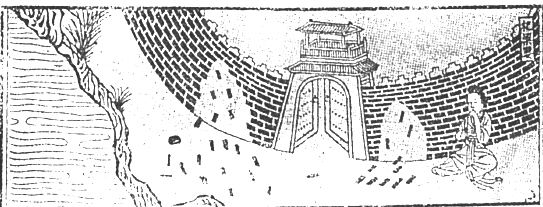Lady Meng Jiang
 Lady Meng Jiang or Meng Jiang Nü () is a Chinese tale with many variations. Later versions of the tale are usually set in the Qin dynasty; in those tales, Lady Meng Jiang's husband was pressed into service by imperial officials and sent as corvee labor to work in the construction of the Great Wall of China. Lady Meng Jiang heard nothing after his departure, so she set out to bring him winter clothes. Unfortunately, by the time she reached the Great Wall, her husband had already died. Hearing the news, she wept so bitterly that a part of the Great Wall collapsed, revealing his bones.
Lady Meng Jiang or Meng Jiang Nü () is a Chinese tale with many variations. Later versions of the tale are usually set in the Qin dynasty; in those tales, Lady Meng Jiang's husband was pressed into service by imperial officials and sent as corvee labor to work in the construction of the Great Wall of China. Lady Meng Jiang heard nothing after his departure, so she set out to bring him winter clothes. Unfortunately, by the time she reached the Great Wall, her husband had already died. Hearing the news, she wept so bitterly that a part of the Great Wall collapsed, revealing his bones.The story is now counted as one of China's Four Great Folktales, the others being the Legend of the White Snake (''Baishezhuan''), Butterfly Lovers, and The Cowherd and the Weaving Maid (''Niulang Zhinü''). Chinese folklorists in the early 20th century discovered that the legend existed in many forms and genres and evolved over the last 2,000 years.
The section of the Great Wall that was toppled in the legend is the Great Wall of Qi in today's Shandong Province. The Temple of Lady Meng Jiang, whose origins are sometimes dated to the Song dynasty, was constructed or reconstructed in 1594, during the Ming dynasty, at the eastern beginning of the Ming Great Wall in Qinhuangdao of Hebei Province. It is still in existence.
Originally "Meng" was not her family name. "Meng Jiang" would have been a very common one for women in the state of Qi, as "Jiang" was the surname of the Qi ruler and much of its nobility, and "Meng" meant "eldest child" not born to the main wife.
In 2006, the legend of Meng Jiang was included in the first collection of national intangible cultural heritage listed by the State Council of China. Provided by Wikipedia
-
1
-
2
-
3
-
4by Lian-Ming Wu, Rui Wu, Yang-Rongzheng Ou, Bing-Hua Chen, Qiu-Ying Yao, Qing Lu, Jiani Hu, Meng Jiang, Dong-Aolei An, Jian-Rong XuGet full text
Published 2017
article -
5by Shuting Zhao, Zhaobin Xu, Hai Wang, Benjamin E. Reese, Liubov V. Gushchina, Meng Jiang, Pranay Agarwal, Jiangsheng Xu, Mingjun Zhang, Rulong Shen, Zhenguo Liu, Noah Weisleder, Xiaoming HeGet full text
Published 2016
article -
6by Meng Jiang, Yue Kang, Tomasz Sewastianik, Jiao Wang, Helen Tanton, Keith Alder, Peter Dennis, Yu Xin, Zhongqiu Wang, Ruiyang Liu, Mengyun Zhang, Ying Huang, Massimo Loda, Amitabh Srivastava, Runsheng Chen, Ming Liu, Ruben D. CarrascoGet full text
Published 2020
article